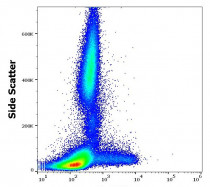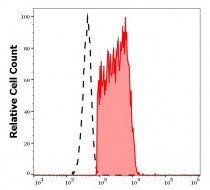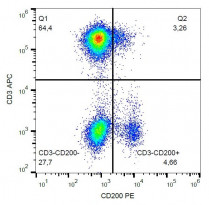ARG54293
anti-CD200 antibody [OX-104] (PE)
anti-CD200 antibody [OX-104] (PE) for Flow cytometry and Human
Cell Biology and Cellular Response antibody; Immune System antibody
Overview
| Product Description | PE-conjugated Mouse Monoclonal antibody [OX-104] recognizes CD200 |
|---|---|
| Tested Reactivity | Hu |
| Tested Application | FACS |
| Specificity | The clone OX-104 recognizes CD200, a type-1 glycoprotein of the immunoglobulin superfamily, which is expressed in neurons, B and T cell subsets, keratinocytes, follicular dendritic cells, and ovarian cells. |
| Host | Mouse |
| Clonality | Monoclonal |
| Clone | OX-104 |
| Isotype | IgG1 |
| Target Name | CD200 |
| Antigen Species | Human |
| Immunogen | Human CD200 |
| Conjugation | PE |
| Alternate Names | OX-2; OX-2 membrane glycoprotein; MOX1; MOX2; CD antigen CD200; MRC |
Application Instructions
| Application Suggestion |
|
||||
|---|---|---|---|---|---|
| Application Note | * The dilutions indicate recommended starting dilutions and the optimal dilutions or concentrations should be determined by the scientist. |
Properties
| Form | Liquid |
|---|---|
| Purification Note | The purified antibody is conjugated with R-Phycoerythrin (PE) under optimum conditions. The conjugate is purified by size-exclusion chromatography and adjusted for direct use. No reconstitution is necessary. |
| Buffer | PBS, 15 mM Sodium azide and 0.2% (w/v) high-grade protease free BSA |
| Preservative | 15 mM Sodium azide |
| Stabilizer | 0.2% (w/v) high-grade protease free BSA |
| Storage Instruction | Aliquot and store in the dark at 2-8°C. Keep protected from prolonged exposure to light. Avoid repeated freeze/thaw cycles. Suggest spin the vial prior to opening. The antibody solution should be gently mixed before use. |
| Note | For laboratory research only, not for drug, diagnostic or other use. |
Bioinformation
| Database Links | |
|---|---|
| Gene Symbol | CD200 |
| Gene Full Name | CD200 molecule |
| Background | CD200 (also known as OX2 or MRC) is a type-1 membrane glycoprotein, which contains two extracellular immunoglobulin domains, transmembrane domain and cytoplasmic domain. It is expressed by neuronal cells, B and T cell subsets, follicular dendritic cells, keratinocytes, and ovarian cells. The interaction between CD200 and its receptor CD200R results in macrophage activation (IL-6 production), inhibition of mast cell degranulation along with reduced TNF-alpha and IL-13 secretion and overall attenuation of the activation status of lymphocytes. It seems CD200 is also involved in maternal tolerance and its decreased expression in hair follicle correlates with follicular miniaturization. |
| Function | Costimulates T-cell proliferation. May regulate myeloid cell activity in a variety of tissues. [UniProt] |
| Research Area | Cell Biology and Cellular Response antibody; Immune System antibody |
| Calculated MW | 31 kDa |
Images (4) Click the Picture to Zoom In
-
ARG54293 anti-CD200 antibody [OX-104] (PE) FACS image
Flow Cytometry: Human peripheral whole blood stained with ARG54293 anti-CD200 antibody [OX-104] (PE) (10 µl reagent / 100 µl of peripheral whole blood).
-
ARG54293 anti-CD200 antibody [OX-104] (PE) FACS image
Flow Cytometry: Human lymphocytes stained with ARG54293 anti-CD200 antibody [OX-104] (PE) (10 µl reagent / 100 µl of peripheral whole blood) and ARG53782 anti-CD19 antibody [LT19] (APC) (10 µl reagent / 100 µl of peripheral whole blood).
-
ARG54293 anti-CD200 antibody [OX-104] (PE) FACS image
Flow Cytometry: Separation of human CD200 positive B cells (red-filled) from neutrophil granulocytes (black-dashed). Human peripheral whole blood stained with ARG54293 anti-CD200 antibody [OX-104] (PE) (10 µl reagent / 100 µl of peripheral whole blood).
-
ARG54293 anti-CD200 antibody [OX-104] (PE) FACS image
Flow Cytometry: Human lymphocytes stained with ARG54293 anti-CD200 antibody [OX-104] (PE) (10 µl reagent / 100 µl of peripheral whole blood) and ARG54302 anti-CD3 antibody [UCHT1] (APC) (10 µl reagent / 100 µl of peripheral whole blood).
Clone References











